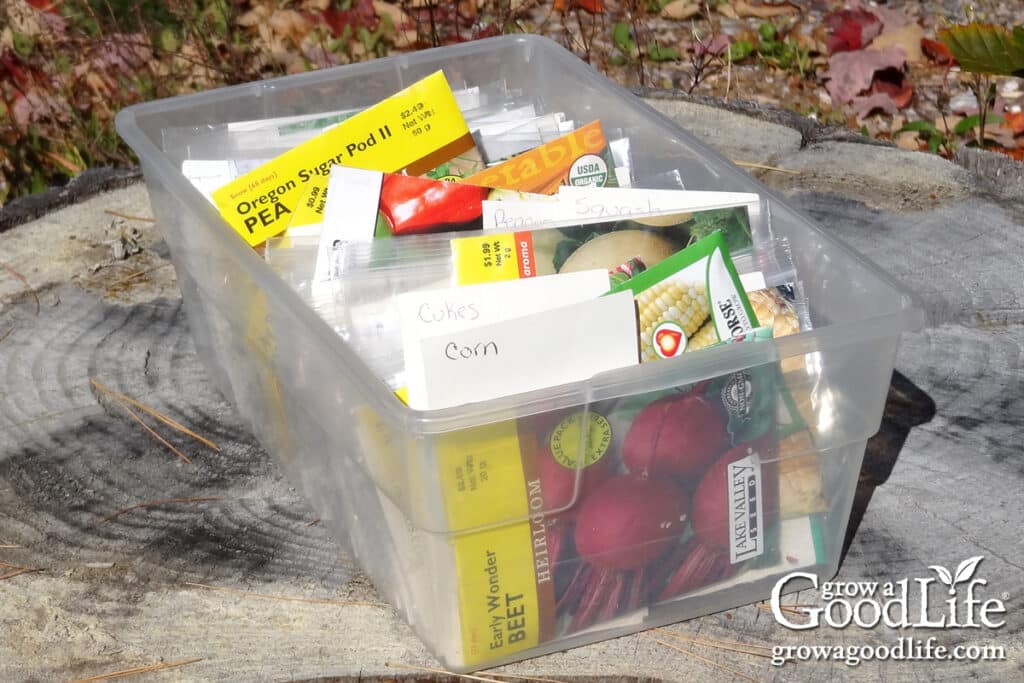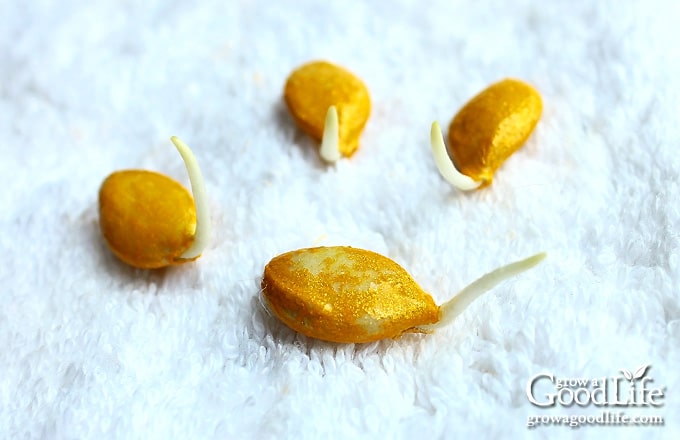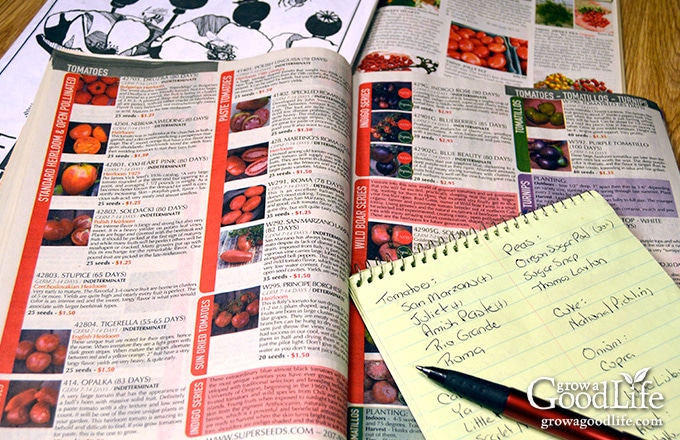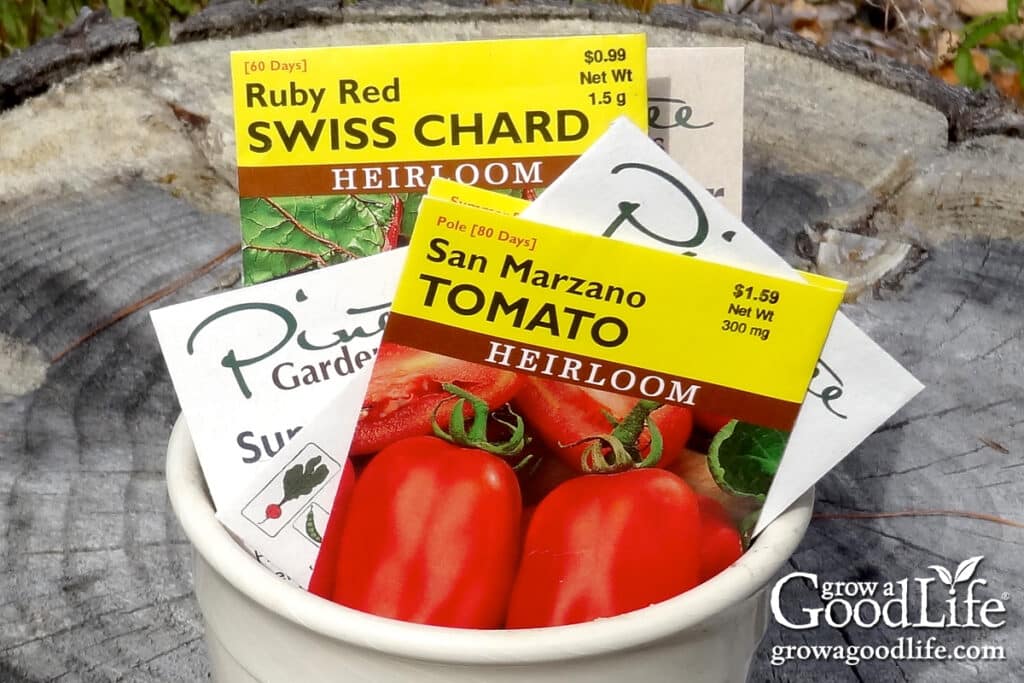Tips for Buying Seeds for Your Vegetable Garden
This post may contain affiliate links, which means that I may receive a commission if you make a purchase using these links. As an Amazon Associate I earn from qualifying purchases.
Ready to plan your garden? Follow these simple tips to buy vegetable seeds for your garden. Learn how to choose crops and shop for high-quality vegetable seeds. Includes seed organization ideas, top seed sources, and easy planning tips.

Successful vegetable gardens begin with high-quality seeds. Whether you prefer flipping through colorful seed catalogs by the fire or browsing your favorite online seed companies, planning and buying seeds is the first real step toward the gardening season. These tips will help you organize your seed packages, determine what you need, and shop smart for seeds that will thrive in your garden.
The Joy of Garden Planning
There’s something magical about planning the garden while snow still covers the ground. Even after years of growing food, I still feel that spark of excitement when the first seed catalogs arrive in the mail. I mark far too many varieties, then spend time going over and trimming my wish list down to what will realistically fit in the garden beds.
Over time, I’ve learned that the more organized I am now, the smoother the growing season will go later. By the time the days start to lengthen and it’s time to set up the grow lights, I already have a clear plan, a tidy seed collection, and the anticipation of another productive year ahead.
How to Plan and Buy Seeds for the Season Ahead
Once the excitement of garden planning begins, it’s easy to feel overwhelmed by the multitude of choices. With hundreds of varieties available and seed catalogs arriving daily, where do you even start?
Over the years, I’ve developed a simple process that keeps me organized and ensures I order only what I need, knowing it will thrive in my garden. Follow these tips to plan your seed order and set the stage for a productive growing season.
1. Organize and Take Inventory of Your Seeds
Before you order anything new, take stock of what you already have.
If you’re like me, you probably have a shoebox (or two) of leftover seed packets tucked away from previous seasons. I store mine in two small plastic totes, one for vegetables and one for flowers and herbs. The seed boxes are divided into sections (i.e., tomatoes, peppers, onions, lettuce, squash, etc.) with dividers made from index cards labeled by crop. Each packet is slipped into a small zip-top bag to keep out moisture and organized into the appropriate sections.

When it’s time to plan, I spread everything out on the table, sort by category, and jot down what I have on hand. Checking inventory before you order prevents duplicates, helps you use older seeds, and provides a clearer picture of what you actually need.
2. Check Expiration Dates and Test Older Seeds
As you sort your seed packets, look for the “packed for” or “sell by” date printed on each label. Most vegetable seeds remain viable for several years if stored properly, but some types lose their vigor more quickly.
Here’s a general guideline for how long most seeds will last:
- 1 year: Leeks, onions, parsnips, scallions
- 2 to 3 years: Arugula, beans, carrots, celery, corn, eggplant, lettuce, okra, peas, peppers, spinach
- 3 to 4 years: Beets, broccoli, cabbage, kale, radish, squash, Swiss chard
- 5 to 6 years: Cucumbers, melons, pumpkin, tomatoes, turnips, watermelons
If you’re unsure whether older seeds will still sprout, try this simple germination test before tossing them. It only takes a few days and can save you from disappointment later: Simple Seed Germination Test.

3. Make a Seed Shopping List
Once you know what you have, it’s time to make your shopping list. I like to keep two running lists: one for varieties I already have, and one for those I want to buy.
I usually begin with tomatoes because they’re the backbone of my garden and pantry. I grow fresh slicers for salads and several paste types, including San Marzano, Roma, and Amish Paste, for canning and sauces. After checking my inventory, I make sure I have enough seeds of my favorite varieties and add a few new ones I’d like to try.
As you work through your list, focus on the crops your family eats most often or the ones that yield the biggest return for your space and effort.
If you love salads, then lettuce seeds, spinach, cucumbers, and tomatoes would be obvious choices to grow in your garden. If you enjoy fresh salsa, be sure to include pepper seeds, tomato seeds, and cilantro on your list.

4. Choose the Right Seeds for Your Garden
When you’re deciding what to grow, think about how much space, sunlight, and time you can dedicate to your garden. Choose vegetables that you and your family enjoy eating, and consider how you’ll use the harvest. A few things to consider:
Climate
Begin by understanding your growing zone and local average last frost and first frost dates, so you can select varieties that are suited to your region. Depending on your climate, you may want to choose vegetable seed varieties that are humidity tolerant, drought tolerant, or disease resistant.
Warm-climate gardeners may need heat-tolerant vegetables, such as okra, peppers, and southern peas, while those in cooler areas will have better luck with hardy crops like kale, cabbage, and root vegetables.
If you’re gardening at high elevation or in a short-season area, look for varieties labeled “early,” “short-season,” or “cold-tolerant” to ensure your harvest matures before frost.
Environment
Think beyond temperature to your garden’s unique growing conditions. Is your summer humid or dry? Do you often battle fungal diseases or drought?
Seed catalogs often note whether a variety is humidity-tolerant, drought-resistant, or bred for disease resistance. For example, I always look for tomato varieties with good blight resistance and mildew-resistant cucumbers because they perform far better in my Maine garden’s damp summer weather.
Sunlight
The amount of sunlight your garden receives each day will influence what you can grow successfully. Most vegetables need at least six to eight hours of direct sunlight to thrive.
- Fruiting crops such as tomatoes, peppers, squash, and eggplant need full sun for strong growth and good yields.
- Leafy greens like lettuce, spinach, kale, and Swiss chard can tolerate partial shade, especially in hot climates where afternoon shade helps prevent bolting. If your garden doesn’t get full sun, here are 30+ Vegetables That Grow in Shade that still produce a satisfying harvest.
- Root crops such as carrots and beets fall somewhere in between. They’ll grow faster in full sun but still produce a modest harvest with a few hours less. Observe how the light moves across your garden through the day and plant accordingly.
Space
Your available space plays a big role in what you can grow. Compact or bush types, such as bush beans, determinate tomatoes, and patio cucumbers, fit well in raised beds or containers.
If you have more room to spread out, vining crops like pumpkins, winter squash, or pole beans can make the most of vertical space on trellises or fences. Mapping out your garden ahead of time helps you see what will fit comfortably without crowding.
Purpose
Finally, think about how you’ll use your harvest. If you love canning, freezing, or storing food through the winter, focus on storage crops such as potatoes, carrots, onions, and paste tomatoes.
If you prefer to eat fresh from the garden all season, plan for quick-growing crops like lettuce, spinach, radishes, and bush beans that can be sown in succession for continual harvests.
If you’re not sure which vegetables to prioritize, this companion guide can help: Choosing Vegetables to Grow.
5. Plan Your Garden Space Before Ordering
It’s easy to get carried away when shopping for seeds (ask me how I know!). Before you place your order, sketch a rough map of your garden. Even a simple outline helps you visualize the actual space you have and prevents overcrowding.
Plot out each crop, keeping in mind how tall or sprawling plants will become. You can also plan for trellis locations, succession planting, and early spring plantings that can be replaced later with heat-loving varieties.
For guidance, check out: Planning Your Vegetable Garden: Mapping the Garden Beds.
6. Order Seeds Early for the Best Selection
Seed companies often release their catalogs in late fall or early winter, and the most popular varieties can sell out fast. Ordering early gives you the best chance to get everything on your list.
In recent years, the surge of new gardeners has led to seed shortages occurring more frequently. If you find a variety you love, consider buying an extra packet or two for next season. Properly stored seeds can last several years.
7. Trusted Seed Companies I Recommend
Local feed stores and farmers’ co-ops have a great selection of seeds that grow well in your area. You’ll find traditional seed packages, but most also offer the option to buy seeds by the scoop. Buying seeds in bulk is more economical, especially when purchasing a larger quantity such as beans, corn, peas, and cover crops.
While local feed and farm stores offer the basics, you can turn to online seed companies for more variety. Over the years, I’ve ordered from many online seed suppliers. The following companies have consistently provided high-quality seeds with excellent germination rates and reliable service. All have signed the Safe Seed Pledge and offer non-GMO varieties.
- Fedco Seeds is a Maine-based cooperative seed and garden supply company that has been in operation since 1978. The seeds I have ordered over the years have always been high quality. Fedco is an excellent source of certified-organic cultivars and regional heirloom varieties. Their catalog reads like a storybook for northern growers.
- Pinetree Garden Seeds is a family-owned and operated business out of New Gloucester, Maine. It was founded in 1979 with a mission to offer high-quality seeds in smaller, more manageable seed packages that are affordable for the typical home gardener. Offerings include heirloom seeds, organic vegetable seeds, gardening tools, books, live plants, and soap making supplies.
- Botanical Interests: You have likely spotted the beautifully illustrated seed packages at your local farm or hardware store. Not only are they attractive, but each package also contains detailed sowing and growing information for each seed variety. The seeds I have planted have had very good germination and produced healthy plants.
- Johnny’s Selected Seeds is an employee-owned Maine seed company initially established in 1973 that offers a wide variety of certified-organic, hybrid, open-pollinated, and heirloom vegetable, herb, and flower seeds. The seeds I have ordered have high germination rates and produce healthy plants.
- Territorial Seed Company is a family owned company in Cottage Grove, Oregon. They have an excellent reputation for quality seeds and customer service. Their catalogs are a wealth of information for growers, and they carry many unique varieties.
- Baker Creek Heirloom Seeds got its start in 1998 in Mansfield, Missouri as a small company that focused on heirloom seeds. It has grown into the largest heirloom seed company in North America. They encourage seed saving and sharing.
- High Mowing Organic Seeds began as a one-person operation in Wolcott, Vermont, with just 28 seed varieties in 1996. Today, it offers over 600 heirlooms, open-pollinated and hybrid varieties of vegetable, fruit, herb, microgreens, and flower seeds. The seeds are of good quality and have great germination rates.
- Seed Savers Exchange is a unique seed company founded in 1975 to protect and preserve heirloom varieties, rather than breeding seeds for increased hardiness and ease of cultivation. It has grown to maintain a collection of over 20,000 different varieties of heirloom vegetable seeds and open-pollinated plants.
8. How to Store Unused Seeds for Next Year
Many seeds will stay viable for years if stored correctly. The key is to keep them cool, dry, and dark.
I keep mine in sealed containers in a cool corner of the basement, away from heat sources. Glass jars or plastic bins with tight lids work well for keeping out moisture and pests.
If you want to maximize seed longevity, follow these detailed tips: How to Store Seeds for Long-Term Viability.

Let the Garden Dreams Begin
Winter is the season of garden dreams, when ideas take root long before the soil thaws. Spend these quiet days organizing your seed stash, testing what you have, and ordering new varieties for the year ahead.
Once your seed packets arrive, the next step is to map your garden and set up a seed-starting schedule. Before you know it, you’ll be back in the garden, hands in the soil, watching those first green shoots emerge.
This article was originally published on January 21, 2015. It has been updated and refreshed with new photos and up-to-date tips to help you plan your best vegetable garden yet!
You May Also Like:
- 10 Steps to Starting Seedlings Indoors
- How to Use Grow Lights for Seedlings
- 8 Easiest Vegetables to Grow
Good planning is key to a successful vegetable garden
Whether you are new to growing your own food or have been growing a vegetable garden for years, you will benefit from some planning each year. You will find everything you need to organize and plan your vegetable garden in my PDF eBook, Grow a Good Life Guide to Planning Your Vegetable Garden.


I’m so glad I found your website! I can’t wait to start planting in my garden and had no idea how much planning or preparation is needed. Because of your easy to follow steps and links, I have started my new gardening composition notebook where I will draw my garden bed maps, keep notes about how well my different plants grew, and list what I will do next time. I would be so disorganized and lost if I hadn’t found you! Thank you for the plethora of knowledge.
Great post! I need to get my ideas down on paper. I am so excited to start planning my garden for the year, I just never seem to be organized enough. Thanks for the tips! ~Lisa M